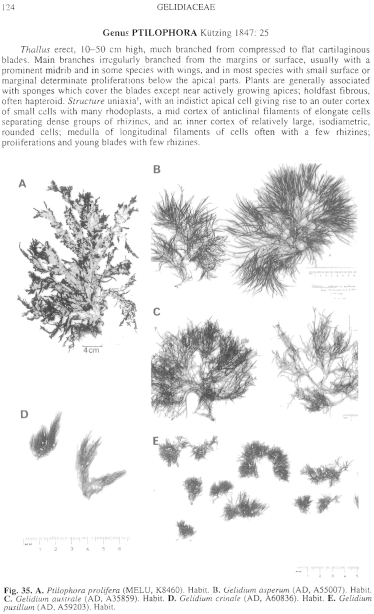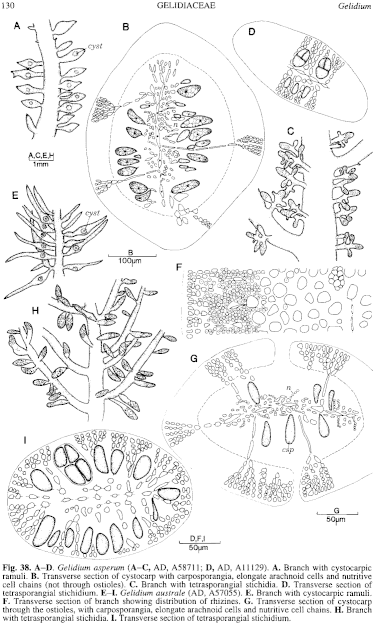|
|
|
|
|
|||||||||||
|
Electronic Flora of South Australia Species Fact Sheet
Phylum Rhodophyta – Class Florideophyceae – Order Gelidiales – Family Gelidiaceae
Selected citations: May 1949b: 197.
Synonym
G. corneum sensu Harvey 1859b: 314. Sonder 1853: 685; 1855: 520?
Thallus (Fig. 35C) medium to dark red-brown, cartilaginous, forming erect, densely branched tufts (5–) 10–25 (–30) cm high, with several to numerous bipinnate axes. Axes tapering only slightly from base to upper parts, subterete to compressed, relatively straight, 0.7–2 mm broad near the base, 400–700 (–1000) µm broad above, distichously branched every (0.5–) 1–3 mm from base to near apices, rarely with unbranched ends 0.5–2 cm long, sometimes partly denuded below; laterals usually crowded and displaced from being strictly distichous. Pinnae 2–8 (–12) cm long and 200–400 µm broad, subterete to slightly compressed, B/T 1.5–2. Pinnules every (0.5–) 1–3 mm on pinnae, irregularly alternate, 2–5 cm long and 100–200 µm broad. Holdfast 2–10 mm across, of slender haptera 200–300 µm in diameter, arising from the base of the axis, and with short stolons; epilithic. Structure (Fig. 38F). Cortex 2–4 cells thick, outer cells in surface view in slight longitudinal rows with the protoplast 3–5 (–6) µm across, wall relatively thin, inner cells becoming radially elongate; medulla of elongate cells with hyphae; rhizines profuse in inner cortex, rare in central medulla.
Reproduction: Fertile ramuli all around or (usually) tending to be on two sides of the pinnules, (0.4–) 1–2.5 (–3) mm long, 60–160 (–200) µm thick, subterete to slightly compressed. Cystocarps (Fig. 38E) single per ramulus, usually just in the basal half with the ramulus tapering above, 200–500 m across, bilocular (Fig. 38G) with a distinct ostiole on each side; carposporangia clavate, 10–25 µm in diameter; elongate arachnoid cells and nutritive cell chains present. Spermatangial sori covering short, basally sterile, ramuli which become branched subdistichously or proliferous, 1–2 mm long and 200–300 µm in diameter, with the outer cortical cells replaced by elongate spermatangial initials from which subspherical spermatangia 1–2 µm in diameter are cut off terminally.
Stichidia (Fig. 38H) clavate to tapering above, with a short to medium stalk, the fertile region 300–800 (–1200) µm long, 150–250 µm broad. Tetrasporangia (Fig. 38I) derived from cortical cells, mixed, lying in the outer medulla all around the stichidia, ovoid, irregularly or regularly decussately or cruciately divided, 30–45 µm in diameter.
Lectotype from Port Phillip, Vic. (Mueller); in Herb. Agardh, LD, 33188.
Selected specimens: Point Sinclair, S. Aust., in deep upper sublittoral crevice (Womersley, 8.ii.1954; AD, A19618). Elliston, S. Aust., 11 in deep (Shepherd, 19.iv.1970; AD, A35859). Wanna, S. Aust., drift (Womersley, 19.ii.1959; AD, A22360). Althorpe Is, S. Aust., 10–13 m deep N side (Baldock, 4.i.1964; AD, A27226). Dubious Rock, West I., S. Aust., 13 m deep (Shepherd, 3.i.1966; AD, A30347). Nora Creina, S. Aust., 3–8 m deep (Owen, 3.ix.1971; AD, A39580). Lawrence Rock, Vic., in rock pools (Beauglehole, 13.i.I954; AD, A20548). Point Roadknight, Vic., drift (Sinkora A1423, 29.xi.1971; AD, A43194). Walkerville, Vic., drift (Sinkora A1597, 23.ii.1972; AD, A43232). Hunter I., NW Tas., upper sublittoral (Bennett, 14.i.1954; AD, A19651). Safety Cove, Port Arthur, Tas., 1–2 m deep (Gordon-Mills, 16.ii.1986; AD, A57055).
Distribution: W. Aust. (Preiss) to Walkerville, Vic. [possibly to southern Queensland (May 1949b, p. 197)] and around Tasmania.
Taxonomic notes: G. australe is essentially a south-eastern Australian species and its western and northeastern limits are uncertain. May (1949b, p. 197) recorded it from "southern Queensland", and her specimens from N.S.W. (in NSW) are more likely to be G. caulacantheum.
G. australe has been recorded from New Zealand (see Chapman 1969, p. 100) but it is doubtfully the same as the Australian species.
G. australe is superficially similar to Pterocladia capillacea but is a more slender species with narrower axes.
References:
AGARDH, J.G. (1872). Bidrag till Florideernes Systematik. Acta Univ. hind. 8, 1–60.
AGARDH, J.G. (1876). Species Genera et Ordines Algarum. Vol. 3, Part 1 - Epicrisis systematis Floridearum, pp. i-vii, 1–724. (Weigel: Leipzig.)
CHAPMAN, V.J. (1969). The marine algae of New Zealand. Part III: Rhodophyceae. Issue 1: Bangiophycidae and Florideophycidae (Némalionales, Bonnemaisoniales, Gélidiales). (Cramer: Germany.)
HARVEY, W.H. (1859b). Algae. In Hooker, J.D., The Botany of the Antarctic Voyage. Flora Tasmaniae. Vol. II, pp. 282–320.
MAY, V. (1949b). Studies on Australian marine algae. V. Observations on and geographical records of various species, particularly those of the Gelidium complex. Proc. Linn. Soc. N.S.W. 74, 196–202.
SONDER, O.W. (1853). Plantae Muellerianae. Algae. Linnaea 25, 657–709.
SONDER, O.W. (1855). Algae annis 1852 et 1853 collectae. Linnaea 26, 506–528.
The Marine Benthic Flora of Southern Australia Part IIIA complete list of references.
Publication:
Womersley, H.B.S. (14 January, 1994)
The Marine Benthic Flora of Southern Australia
Rhodophyta. Part IIIA, Bangiophyceae and Florideophyceae (to Gigartinales)
Reproduced with permission from The Marine Benthic Flora of Southern Australia Part IIIA 1994, by H.B.S. Womersley. Australian Biological Resources Study, Canberra. Copyright Commonwealth of Australia.
Illustrations in Womersley Part IIIA, 1994: FIGS 35C, 38 E–I.

Figure 35 enlarge
Fig. 35. A. Ptilophora prolifera (MELU, K8460). Habit. B. Gelidium asperum (AD, A55007). Habit. C. Gelidium australe (AD, A35859). Habit. D. Gelidium crinale (AD, A60836). Habit. E. Gelidium pusillum (AD, A59203). Habit.

Figure 38 enlarge
Fig. 38. A–D. Gelidium asperum (A–C, AD, A58711; D, AD, A11129). A. Branch with cystocarpic ramuli. B. Transverse section of cystocarp with carposporangia, elongate arachnoid cells and nutritive cell chains (not through ostioles). C. Branch with tetrasporangial stichidia. D. Transverse section of tetrasporangial stichidium. E–I. Gelidium australe (AD, A57055). E. Branch with cystocarpic ramuli. F. Transverse section of branch showing distribution of rhizines. G. Transverse section of cystocarp through the ostioles, with carposporangia, elongate arachnoid cells and nutritive cell chains. H. Branch with tetrasporangial stichidia. I. Transverse section of tetrasporangial stichidium.

|
Email Contact: State Herbarium of South Australia |

|